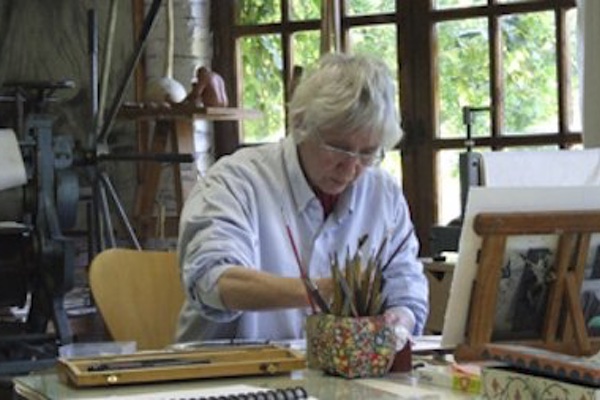“It seems almost impossible that our actions
can affect anything as vast as the oceans.”
by Emily Jaeger, Features Editor

Barbara Milman is an artist living and working in the San Francisco Bay Area specializing in prints. Her work has been exhibited in many solo and group shows, both nationally and internationally, and is included in museums and many other public collections. Her artist’s books are included in the special collections of many museums, public libraries, and university libraries, including the National Museum of Women in the Arts, the New York City Public Library, and the Chicago Art Institute.
Barbara Milman’s prints, featured in July’s issue, call to mind the famous Frederick Buechner line: “Your vocation in life is where your greatest joy meets the world’s greatest need.” Milman, in her second career as an artist (she used to work in law), began making prints and limited edition artist books in 2004 devoted to the subject of climate change. Her beautiful prints, which incorporate bright colors, abstract shapes, and organic forms, explore the impact humans have on their environment.

Milman’s embrace of the fine arts as a full-time career was long in the making. She had always loved making art as a child, but ended up following a different path as an adult. Milman told Art is the Answer: “For reasons that are not very clear to me today, I took a twenty-five-year detour to become a lawyer, doing art only in my spare time.” When she finally quit her legal job in 1994, she found a great deal of fulfillment and joy in turning to art full time: “It made me happier, and, according to my husband, it also made me a nicer and more relaxed person.”

Climate change, a perennial concern, has taken a center stage in Milman’s artwork: “I grew up on Long Island, near the Atlantic Ocean. One of the great pleasures of my childhood was going to the beach, walking in the dunes, swimming in the waves. For the past thirty years I have lived near the Pacific Ocean, which is different but equally wonderful. It seems almost impossible that our actions can affect anything as vast as the oceans—unfortunately it is increasingly clear that we are slowly destroying the life of ocean.”

In her series featured in The Woven Tale Press, Milman explores the effects of oil spills, such as the Deepwater Horizon spill in the Gulf of Mexico. Jellyfish are a prevalent image in the series because they are often the lone survivors of these oozes of fossil fuels, which kill most creatures in their path.
Milman’s prints combine linocuts, monotypes, and digital inkjet printing. The advantage of her medium, Milman explains, is the ability to reuse and repeat segments of her prints ad infinitum. In this way an image such as jellyfish can evolve into a tie connecting works together. Also, rather than spend her creative energy coming up with new images or depictions in each piece, Milman can focus on variations on a single theme. The challenge of making an old image new and strange is both exciting and freeing.

In addition to her vibrant prints, Milman is also the author of a myriad of artist’s books. Many of her books also address climate change, though she has done some projects on other subjects, such as preserving the accounts of Holocaust survivors. Unlike her individual prints, Milman’s author books often involve 3-D elements and multi-media. For example, in Unnatural Histories: No. 86, the cover of the book is constructed from a cigar box. While the inside of one cover contains the narrative text, “Seaside Stories,” the other side is constructed of printed paper folded into waves.

Milman’s artist’s books are slightly different creatures from her individual prints. Perhaps both the concept of narrative—a plot unfolding—and the physical mysteries of these books—how will they physically unfold, what strange sculpture will emerge on each page—lend these books a heightened anticipation of discovery. In her artist’s books, Milman engages the reader again and again with the harsh reality of climate change, spurring us to ask how we might end this story differently.
Copyright 2017 Woven Tale Press LLC. All Rights Reserved.

